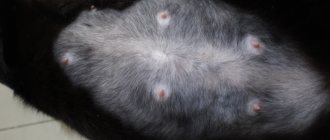If a purulent pimple breaks out on the stomach, paw, face, behind the ear or in the throat, then an abscess may occur in the cat. The disorder is characterized by the accumulation of fluid in a wound on the skin. With pathology, the pet becomes less mobile, does not follow commands and may refuse to eat. If you promptly consult a veterinarian in case of an abscess on the neck or in the area of the anal gland, the disease does not pose a threat to the life and health of the pet, and the wound heals quickly. When the boil festers and the necessary treatment and care for the cat is not provided, an abscess occurs that can cause serious complications, including sepsis and death.
Factors influencing the appearance of pathology
Veterinarians note that mechanical damage is the most common cause of abscesses in kittens and adults in the ear, mouth, cheek and other areas of the skin.
Since felines are predators, fights often occur among identical individuals, resulting in scratches, teeth marks and other injuries that can lead to the formation of a boil with pus. Other types of damage in cats can also affect the development of pathology:
- being hit by a car;
- blow with a piercing object;
- falling from a great height;
- paw damage from a splinter;
- injury to the oral mucosa by a bone or foreign object.
Improper intramuscular injection often leads to such a problem in an animal.
When a mechanical injury occurs, pus collects under the skin, which subsequently causes abscesses. It is strictly forbidden to open the resulting boils yourself, as this will lead to infection. Other reasons can also affect an abscess in cats:
- Dental diseases. If a pet has a broken tooth, caries, or periodontal disease, there is a high risk of abscesses.
- Performing intramuscular or subcutaneous injections with insufficient compliance with antiseptic rules.
- Furunculosis, hematomas and other disorders after injuries, which are accompanied by a purulent-inflammatory reaction.
- Inflamed paraanal glands.
Older cats, as well as pets with weak immune system defense mechanisms, are more susceptible to developing an abscess. Another predisposing factor in the progression of the pathological process are secondary diseases. When keeping a pet in unfavorable conditions, where there is a lot of dirt, the risks of injury and the development of an abscess increase.
Why can cats develop an abscess?
An abscess, as a rule, develops as a result of infection in a wound of even a small size. Most often, wounds on the body or mucous membranes of an animal occur as a result of:
- fights between cats, especially during heat;
- eating small bones and solid food, as well as in the absence of oral hygiene of the cat (in this case, the oral mucosa is affected);
- scratches and punctures from branches, grass, pebbles, thorns, needles;
- subcutaneous injections of poorly soluble drugs;
- non-compliance with sanitary standards for intravenous, intramuscular or subcutaneous administration of drugs (for example, an infection can be caused by an unsterile needle, as well as if sterility standards are not observed);
- bird attacks;
- bites from other animals.
An abscess does not always occur at the site of the lesion. It all depends on the size and depth of the wound, as well as the bacterial microflora that got into it. Thus, most often suppuration is caused by staphylococci, streptococci, Escherichia coli, Pseudomonas aeruginosa, anaerobic bacteria, and mycoplasmas.
Which animals are at risk?
The following categories of pets are most at risk of developing suppuration:
- stray - they most often get into fights with other animals;
- males, especially up to the age of seven, fight more often than females;
- uncastrated pets who often visit the street - this category is considered by other cats as potential rivals, which is why skirmishes also flare up;
- cats and cats with weakened immune systems.
Cats that go outside are at risk for developing abscesses
What types are there?
Most often, such formations occur on the animal’s paws.
More often, a cat's paw breaks out and hurts, but there are cases when a broken abscess is noted on the head or in the torso area. Depending on the location, dental and skin abscess are distinguished. There are other types of pathological process presented in the table:
| Variety | Short description |
| Cold | The disease has a chronic course |
| The abscess has frequent relapses | |
| It may take several months, or even years. | |
| Superficial | It appears when you open a cat’s pimple under the skin yourself |
| Rarely complicated | |
| Deep | Observed as a dense formation in the deep layers of the epidermis |
| This type of disorder is more complex than a superficial one and requires urgent treatment. | |
| Acute | Opening an abscess occurs quickly and often leads to irreversible complications |
| Benign | Inflammation is accompanied by white or yellow discharge |
| This form of the disease in kittens and adult animals quickly passes | |
| Malignant | Signals a weakened immune defense |
| When the oral mucosa is affected, an unpleasant odor is observed |
Alarming symptoms
When the paw is affected, the animal begins to limp.
An opened abscess in a cat on the neck or other area should not be ignored, as it can lead to an abscess. In case of pathology, the owners notice that the pet’s purulent pocket has burst and all the exudate comes out and spreads to healthy tissue. If there is a deviation in a pet, the following symptoms are observed:
- Pain syndrome. At the site of suppuration or in a nearby area, severe pain is felt, especially upon palpation.
- Impaired operation of the damaged part. If the abscess is fixed on the leg, then the cat may begin to limp; if there is a lesion on the neck, the pet tries to move its head less.
- Refusal of food. This symptom is especially observed in domestic animals in which the boil has opened in the oral cavity.
- Hair loss at the site of injury. If the problem affects a Sphynx cat, the abscess will be noticeable on the skin.
- Discharge of blood and pus from the wound.
- Unpleasant odor from the festering area.
- Lethargic condition of the pet and fever. In advanced cases, the temperature can rise to 40 degrees.
If the abscess is fixed in the area of the paraanal gland, then the owners notice a large, red lump near the anus.
Treatment methods
Fighting abscesses are treated surgically by veterinarians. The capsule is opened, the pus is released, and the walls of the cavity are sanitized. Sutures are placed and a drainage is inserted to drain the exudate. Oral or parenteral antibiotics are prescribed or dispensed with. At the discretion of the veterinarian, the operation can be performed without sutures. The wound is sanitized with one of the following means:
- Chemi spray;
- Zooderm;
- Ranozol.
The dental abscess is opened, the mouth is washed with an antiseptic, and antibiotic injections are prescribed. For nutrition, use wet ready-made food of premium class or higher.
With paraproctitis, cleaning the perianal glands helps, which is carried out by a veterinarian or an experienced felinologist. The affected area is treated with chloramphenicol ointment or chlorhexidine. If an abscess has formed or a fistula has formed, the anal glands are removed, sutures are placed, and treated with a wound-healing ointment, powder or spray, which will be prescribed by a veterinarian.
What is the danger?
If the formation is not treated properly, it can result in sepsis for the pet.
If, after opening, the cat’s boil is not treated in time, then unpleasant consequences are possible. An abscess is often complicated by the following disorders:
- proliferation of affected areas and formation of phlegmon with pus;
- tissue death;
- blood infection;
- sepsis;
- death of a cat.
Diagnostics
To diagnose flux, methods such as questioning, examination, and additional research methods are used: radiography, ultrasound, computed tomography, magnetic resonance imaging, blood test data, culture of exudate, etc. An experienced maxillofacial surgeon who treats patients with flux, can, based on the patient’s complaints and examination, carry out an accurate topical diagnosis of the disease (localization of pus) and select the optimal surgical approach to ensure sanitation of the purulent focus and adequate drainage.
Diagnostic procedures
An abscess can appear in pets after sterilization or under the influence of other negative factors. When the first symptoms develop, you should contact a veterinarian who will help you properly treat the disease without causing complications. Before treatment, a comprehensive diagnosis is carried out to determine the source of the abscess, its type and severity. The cat needs to undergo the following diagnostic procedures:
- laboratory testing to determine the causative agent of the disease;
- antibiotic sensitivity test.
During differential diagnosis, the presence of a hematoma in the animal should be excluded.
No less important is differential diagnosis, which helps to distinguish an abscess in a cat from pathologies such as:
- cystic formation;
- benign or malignant tumor;
- granuloma;
- hematoma;
- lymphoextravasate.
Prevention
The fight against combat abscesses is ineffective. A cat walking on the street will definitely fight, and the potential harm to health from the use of sedative drops and tablets exceeds the danger caused by suppuration. If the cat is well fed with ready-made premium food or higher, he will cope with the infection on his own.
If a cat has an unpleasant smell from his mouth, a yellowish-brown coating is found on his gums, his teeth are cleaned at the clinic and he is prescribed Hills t/d therapeutic food.
The granules contain an increased amount of fiber with organized fibers that remove plaque from the gums and teeth. Nutrition gives the cat a feeling of fullness, prevents obesity and urolithiasis.
Prevention of abscesses of the paraanal glands consists of regular cleaning, quarterly deworming, and providing adequate nutrition with ready-made premium food or higher.
How to treat?
Necessary antibiotics
Many owners open a boil on a cat at home, but do not pay due attention to treating the wound, which causes an abscess. To treat the pathology, you need to contact a veterinarian who will tell you how to cure the pathological process and alleviate the pet’s condition. Since the violation is associated with the introduction of pathogenic microorganisms into the wound during an injection or injury, the pet is prescribed antibacterial drugs. It is recommended to use medications that are sensitive to harmful microflora. In most cases, the specialist prescribes the following broad-spectrum antibiotics for the cat, presented in the table.
| Group | Medicine |
| Penicillin series | "Ampicillin" |
| "Oxacillin" | |
| "Carbenicillin" | |
| Tetracycline | "Tetracycline" |
| "Oxytetracycline" | |
| Cephalosporins | "Cephalexin" |
| "Kobaktan" | |
| Macrolides | "Azithromycin" |
| "Tylosin" | |
| "Ericycline" |
In case of an abscess, veterinarians will use antiseptics for external treatment of wounds. Effective are "Vinilin", "Chlorhexidine" and "Miramistin".
Carrying out the operation
After surgery, the animal's wound is drained.
In case of advanced abscess in a cat, which cannot be treated with conservative methods, surgical intervention is required. During surgery, it is necessary to open a purulent wound, remove the purulent contents from it, after which it is sutured. Latex tubes are inserted into the resulting cavity, which are a special drainage system to cleanse the cavity of accumulating pus. After the operation, the owners need to treat the seam by applying various ointments.











